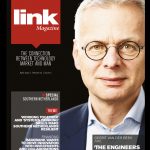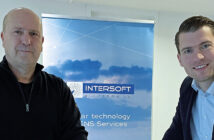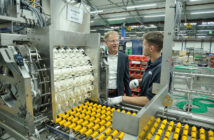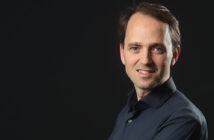Gerrit van der Beek has become one with the Southern Dutch high-tech region. But that does not apply to AME that he is in charge of. This Eindhoven-based system supplier operates in various markets with often foreign customers and has – vertically integrated as it is – a modest local supply base. But that region is crucial for the quality of his staff. People with the ability to collaborate and system architecture. The two core qualities with which the region has gained world renown.

AME benefits from the availability of people with the ability to collaborate and system architecture, two qualities with which the Southern Netherlands region has gained world renown. Gerrit van Beek is convinced that ‘without these qualities, this region would never have been able to develop and build the highly complex systems with which it scores worldwide, the ASML EUV chip machine being the first.’ Photo: Bart van Overbeeke.
THEME: ‘WORKING TOGETHER’ AND ‘SYSTEMS THINKING’ SKILLS MAKE THE SOUTHERN NETHERLANDS RESILIENT
Gerrit van der Beek knows the Southern Dutch high-tech industry like the back of his hand – a sector that he has experienced in his career from a variety of perspectives. Earlier as vice president purchasing and senior vice president R&D at two major OEMs, Philips and FEI (later acquired by Thermo Fisher) respectively. Then as CEO of Liteq, a start-up and one-stop manufacturer of machines for semi-conductor backend processes (now part of Kulicke & Soffa). And now as CEO of AME, a medium-sized, highly vertically integrated system supplier. In order to underline his connection with the Greater Eindhoven region, he currently also holds supervisory directorships at machine builder/system supplier AAE and at Brainport Development, the network of high-tech suppliers, mainly from the south of the Netherlands.
Three popular technologies
The state of being one with the region applies to Van der Beek personally, but not so much to his AME. It goes without saying that the fast-growing company (with an average annual turnover growth of 20 percent over the past decade) is heavily dependent on the Brainport labour market for the recruitment of technical staff. But that does not apply to the clientele and the supply chain. ‘We focus’, he begins his explanation, ‘not so much on markets, but on three technologies: power conversion, IoT and sensing & actuating. Three technologies that are very popular because they are needed for the electrification that is going on in many different markets. A great many companies in a great many divergent markets need our technologies to make their products smart.’
Vehicle-to-grid system
One of those companies is Nissan Automotive Europe in Paris. With the close involvement of stakeholders such as grid managers and energy suppliers, AME has developed a module with which electric cars can be charged ‘interactively’. ‘When a lot of electric cars are on the road in the near future and everyone plugs in their cars at six o’clock in the evening, the electricity grid becomes overloaded. Our vehicle -to-grid system (V2G, ed.), equipped with an app, ensures that the charging rate takes your schedule into account. If you enter on your smartphone that you have to go out for a long drive the next morning at seven o’clock, the system will make sure you have enough power in the battery the next day. But it may well be that in the first hour after you return home, power was drawn from the battery in order to meet the great demand for power at that particular moment.’
Divergent markets
The development of this ‘bi-directional system’ requires the use of all three of AME’s core technologies. ‘But we also use these for many other smart electronic modules. Such as the HMI (human-machine interface, ed.) front panel and the power module for industrial coffee machines. And for the control of a Bruynzeel filing system: On an interface, the user enters the book or document he wants; then the rack where it is opens up and you are led to it by a trail of light. We also use them for the system we developed and built to control Vanderlande’s distribution technology. All companies in totally different markets. Where many companies in this region would seriously suffer if the semicon were to collapse, it would hardly affect us’, says Van der Beek, showing a graph of the turnover development achieved in 2019 and forecast for 2020 on the big screen in the meeting room where the interview takes place. ‘Last year turnover was 38 million euros, this year we expect to grow to 43 million euros. A conservative estimate; I myself think we’re more likely to reach 50 million.’
Standardised
It is striking that he refers to a number of large international companies. Companies that you would say have the capacity to develop those systems themselves, also because these systems are close to their own core technologies. ‘We can do it faster and cheaper. Over the years we have built up an enormous knowledge backbone on which we can draw for new products. A great deal of what we develop is based on knowledge and is built up from components that we have previously developed for completely different products. Of course, we do this in close coordination with our customers. The customer-specific systems we develop and build are therefore largely based on reused knowledge, often and increasingly laid down in standardised platforms.’
Great deal of technology in-house
What also stands out in the graph he shows (made in SAP, based on current data from ERP, PDM and MES, he proudly says) is the great added value that AME produces. This has everything to do with the strong vertical integration of the company, which has a great deal of product technology in-house. Within walking distance of each other, the two buildings in Eindhoven house an SMT (Surface Mount Technology) line, milling equipment, 3D printers, an injection moulding plant, ultrasonic welding equipment, et cetera. ‘We can injection-mould pianoblack here: produce high-gloss black plastic parts. Hardly any other company in Europe is capable of that’, he says, sounding convinced. ‘And we’ve developed a technology here for making integrated connectors. They cost me a few cents now, compared to a few euros if I were to purchase them separately.’
More expensive?
But does keeping so many processes live and up-to-date not make AME actually more expensive for the customer? ‘Pianoblack is extremely vulnerable: It is very susceptible to scratches. If we could have it made elsewhere, it would have to be properly packed there, carefully transported and unpacked here again. That costs money. Another advantage is that we are a high-mix, relatively low-volume company. A specialised injection moulding plant only becomes more cost effective if it can produce very large series. The same goes for PCBs: A specialised EMS (Electronic Manufacturing Services) company is not interested in relatively small series of one hundred to a few hundred thousand pieces at most. In addition, they have to adjust their systems specially to the size of the board we need, whereas that is the standard size for us.’
People
AME thus has customers in various markets, in the semicon, as well as in automotive, medtech and logistics, and in the Southern Netherlands region, but also in Germany, France, Belgium, Great Britain and Turkey. And AME has suppliers from the region, but does many things in-house. AME attracts above all engineers from the surrounding industrial ecosystem. People boasting the wide range of engineering qualities his company needs, from mechanical and electrical to (embedded) software. At the same time people equipped with two other qualities. Qualities that are characteristic of southern Dutch industrial culture.
‘No, it’s not for the engineers that I should be based here’, Van der Beek says. ‘Still, I wouldn’t dream of leaving this region, because for one thing the engineers here generally excel in collaboration. And there are plenty of people here with system architecture qualities who are able to keep track of complex development projects. Without these two qualities, this region would never have been able to develop and build the highly complex systems with which it scores worldwide, the ASML EUV chip machine being the first. Precisely because our engineers can work well together with the client, they are able to gain an excellent understanding of their application, which our module is going be a part of. It is precisely by working closely with their people during the development process that we are able to deliver a module that really adds value. At the same time, we develop complex systems in which a multitude of different disciplines come together. We have the people in-house who know how to keep track, who ensure that all those subsystems work well together. Our system architects are crucial to our success.’
Development and construction region
Van der Beek’s conviction is that without those two social qualities, high-tech technology in the South of the Netherlands would never have become the development and construction sector for the most complex, most accurately functioning systems manufactured on this globe. ‘These two core qualities are indispensable. That is why I’m personally not at all afraid that an EUV machine can be copied by an Asian customer. Certainly not if you have to do it without the code of the embedded software, which is the glue that bonds all the components together.´

The late founder Marc van Sloun: Where the idea is born and where vision and courage lead the heart, the journey through time begins, and dreams come true.
Multinationals
So AME is growing fast and wants to keep growing, especially with the large, multinational customers, according to Gerrit van der Beek. ‘At the beginning of my career, I was responsible for the global procurement of imaging systems at Philips, worth EUR 1 billion a year. AME already existed at the time, but was much smaller than it is now and that’s why I totally overlooked it. Now, as a purchaser at Philips, I would definitely work with AME. No, we’re not doing any business with Philips yet. And not with Thermo Fischer and Kulicke & Soffa either. But I’m sure we can add a lot of value to them.’
AME: original design manufacturer
AME (Applied Micro Electronics) is an developer and manufacturer of high-quality electronic modules and products, an original design manufacturer, as CEO Gerrit van der Beek calls it, alluding to OEM (original equipment manufacturer). The Eindhoven-based company, in which investor Gimv acquired a majority share in March, has around 260 staff, most of whom work in product and process development. The focus is on three core technologies: power conversion, the internet of things and sensors and actuators, with the corresponding highly automated production facilities. In order to attract suitable talent, the company maintains close contact with universities for work placements and graduation projects, especially Eindhoven University of Technology, where the founders graduated. The company motto is contained in a saying that one of the founders, the late Marc van Sloun, once found on the wall of the zeppelin shipyard in Friedrichshafen, Germany: ‘Dort, wo die Idee entspringt, Vision und Mut das Herz bestimmt, beginnt die Reise durch die Zeit, und Träume werden Wirklichkeit.‘ (‘Where the idea is born and where vision and courage lead the heart, the journey through time begins, and dreams come true.’)






